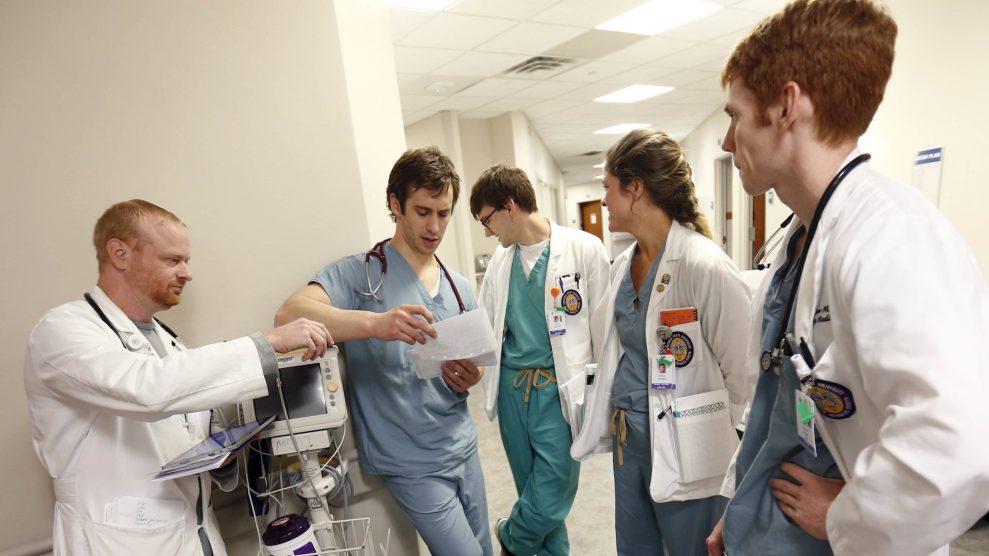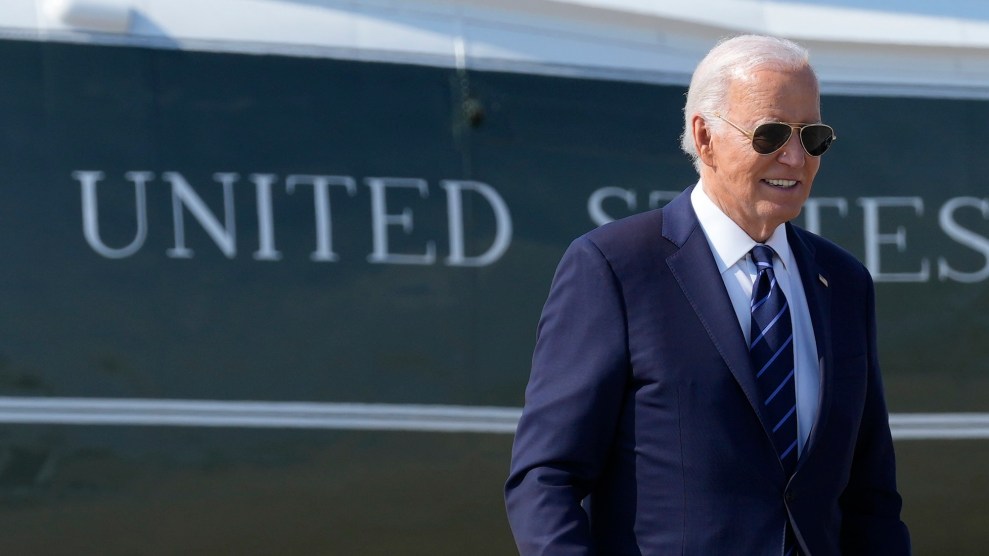
Medical residents go over patient information with medical students.Gerald Herbert/AP
On Saturday, March 14, Avery Thompson and 650 other medical students at the University of California, San Francisco, received an email: Clinical classes were going online and planned hours in the hospital were being put on ice. The spread of the novel coronavirus posed too big a threat for courses to continue in person. In conversations with friends, she said, “We were all experiencing similar frustration at feeling like we weren’t able to do very much.” Within hours, the second-year medical student received another message. This time, from her peers. It linked to a Google Doc in which medical students and pupils from other UCSF programs—pharmaceuticals, PhD students—were drumming up ways to make themselves useful to the medical community. Within days, almost 200 students offered help, 120 from the medical school alone.
“It really just sort of snowballed,” said Hope Schwartz, a first-year medical student at UCSF. “And people started reaching out and coming up with other great ideas.” Some suggested running a blood drive; others planned to redraft public health information for the multilingual Bay Area and track down “other industries that use personal protective equipment—construction companies and nail salons.”
“Students have had the bandwidth to plan out a lot more,” Dr. John Davis, associate dean of curriculum at the medical school, said. “They mobilized immediately, as soon as Covid-19 became an issue.”
As the official number of coronavirus infections begin to skyrocket—on Monday, it was 35,000; 70,000 on Thursday, and by Friday afternoon there were over 100,000 cases—the nation’s health care apparatus has reorganized itself to face the pandemic head-on. Nonessential surgeries are being canceled, and hospitals are pleading with the public to abide by CDC recommendations of social distancing and handwashing in an effort to prevent overwhelming medical services. For medical schools, still in the middle of the academic year, clinical rotations have ground to a halt. Many instructors are too busy on the frontlines to teach, and the presence of untrained medical students could worsen supply shortages or accidentally spread the disease. Meanwhile, schools have tried to react to a quickly changing health emergency without losing sight of their responsibility to educate future doctors.
These new conditions have fundamentally changed the lives of the nation’s 30,000 medical students in two ways. First, course curriculums have reshaped themselves to fit into a world disrupted by the pandemic. Second, the coronavirus has offered students an opportunity to provide ancillary support for frontline health care workers. Across the country, students are mobilizing to meet the specific needs of the medical community in creative ways: from babysitting for nurses to 3D-printing personal protective equipment, like masks.
For many, the crisis goes to the heart of why they wanted to be doctors in the first place. “I do feel that medical students go to medical school mostly because we want be helpful,” says Orly Farber, a third-year medical student at Stanford Medical School. “We don’t write that in our essays because it’s too simplistic a reason, but it’s reality.” At Stanford, medical students are providing childcare, running errands, and going grocery shopping for the doctors and nurses whose days are fully devoted to fighting the virus. Farber thinks it’s possible their role may even be expanded by being asked to take clinical notes, make phone calls to patients, and help with orders, all tasks can be handled remotely.
In other schools, where shortages of equipment are also a concern, students are turning to technological solutions. With the materials necessary for homemade masks in short supply, students at the Rutgers New Jersey Medical School and the University of North Carolina School of Medicine have started 3D-printing face shields, which can be mass produced. “They’re cheap and easy and the most extreme thing you’d need,” says Diana Dayal, a fourth-year student at UNCSM. “If anything, we’re making the more robust product.” Some of the 170 student volunteers from UNCSM and adjacent programs are also working as “hall monitors,” helping medical workers properly “don and dox”—put on and take off—protective equipment to prevent contamination. Some Rutgers students are running a hotline at the New Jersey Poison Control Center to set the record straight for callers who’ve been inundated with misinformation about the pandemic.
For the public, even the right information can be hard to interpret. Students at the University of Pittsburgh School of Medicine are collaborating with their counterparts at New York University and the Pittsburgh Center for Autistic Advocacy to rewrite Centers for Disease Control guidelines. “We’re working as a collective effort to take these CDC guidelines and distill them down to different reading levels, so they’re accessible for a broader audience,” said Ben Zuchelkowski, a fourth-year medical student at Pittsburgh. Once the new guidelines are ready, he hopes his colleagues can disseminate them nationally.
All of the students I spoke with emphasized they could expand beyond their institutions to collaborate around the country. Across messaging applications like Slack, video-conferencing services like Zoom, and Twitter and Google Drive, students have stayed in touch: “We’re sharing ideas with each other, doing conference calls once we make a connection,” Zuchelkowski says. “It’s really been a robust organizational effort nationally.” There’s even a Google file called “Schmeddit,” where everyone can keep up to date on which programs are closed or have affiliated hospitals with confirmed COVID-19 patients.
Meanwhile, medical schools are quickly rewriting curriculums to lean on the same remote communication tools. For UCSF students, classroom courses “rapidly moved to distance and remote learning methods,” said Dr. Davis. “Those are things we could deploy quick.” It’s the same story at most other medical schools. But that’s where the similarities end. “We don’t have a nationally standardized curriculum,” he said. “Every medical school has, for all intents and purposes, its own curriculum. Each interruption in clinic and classroom activities has to be contextualized—and that’s where real complexities occur.”
Those complexities become even more fraught in the clinical setting, where students spend the majority of their third—and some of their fourth—years. Given the severity of the pandemic, clinical rotations—when students experience aspects of the profession, like surgery or primary care, in 4- to 8-week increments—have been canceled for now.
So how do you teach medical students to become doctors when their presence in a hospital is a health risk? “There’s no clear sense of how this school is going to deal with it,” said Krunal Amin, a second-year student at Duke University School of Medicine, where classes have been canceled until June 15. At UCSF, Dr. Davis said faculty members are discussing shifting clinical education from time-based to competency-based, allowing for “a bit more freedom.” In cases where that’s not possible, he’s proposed “uncoupling” courses. Instead of classroom instruction and hospital hours happening simultaneously, for instance, the first comes now, the latter after the virus subsides. Avery Thompson, the UCSF second-year, said, “They’re making the best out of a pretty bad situation, and I do appreciate that.”
Still, not everything can simply be rescheduled. Dayal says one crucial exam, which third-years take to determine where they’ll spend their first years as doctors, has been canceled. This week, most schools typically have Match Day, a celebration where fourth-years learn what that determination is. This year, celebrations moved from auditoriums illuminated in camera flash to email inboxes.
Graduation ceremonies have been canceled, but some medical schools in Boston and New York have enlisted their fourth-year students to start practicing. On Tuesday, NYU’s medical program sent out an email announcing it would graduate some of its fourth-year students three months early, so they “could join the healthcare workforce prior to the typical June 1 starting date.” New York City faces the highest concentration of infections in the country, and NYU University Medical Center is at the center of it all.
That need is trickling down to younger students, too. Last week, North Carolina’s Department of Health and Human Services—which has COVID-19 test samples but not enough technicians to process them—sought out students with lab experience who could help expedite the work. Similarly, the Allegheny County Medical Reserve Corps has reached out to students to help bolster numbers.
“I feel in the coming weeks we’re going to need backups to assist an overwhelmed healthcare workforce,” said Farber, at Stanford Medicine. “Medical students can help reinforce the frontline.”
The reality of being in the midst of a deadly pandemic, with many health care workers struggling to get basic supplies, and no clear end in sight, has created demands that are daunting to even seasoned physicians. I asked Diana Dayal, the UNCSM student, if she ever second-guessed her choice to pursue medicine. “Absolutely not,” she said. “I think it’s inspiring to have a skill set—to really be there for people at their darkest time, even if on a pandemic scale.”

















